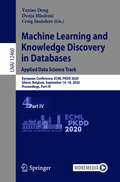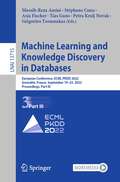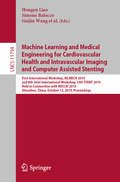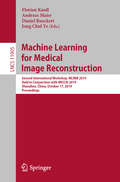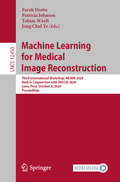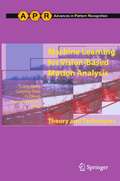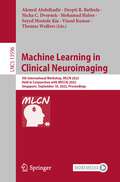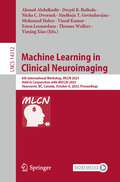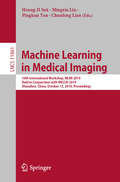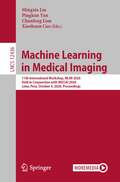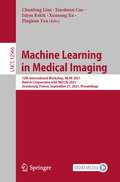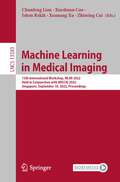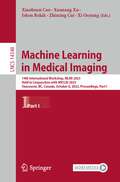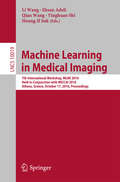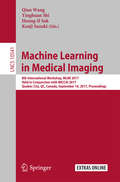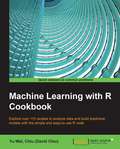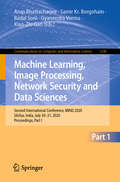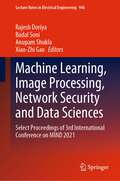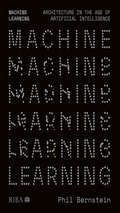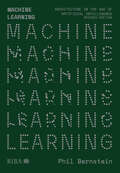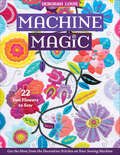- Table View
- List View
Machine Learning and Knowledge Discovery in Databases: European Conference, ECML PKDD 2020, Ghent, Belgium, September 14–18, 2020, Proceedings, Part II (Lecture Notes in Computer Science #12458)
by Kristian Kersting Frank Hutter Jefrey Lijffijt Isabel ValeraThe 5-volume proceedings, LNAI 12457 until 12461 constitutes the refereed proceedings of the European Conference on Machine Learning and Knowledge Discovery in Databases, ECML PKDD 2020, which was held during September 14-18, 2020. The conference was planned to take place in Ghent, Belgium, but had to change to an online format due to the COVID-19 pandemic.The 232 full papers and 10 demo papers presented in this volume were carefully reviewed and selected for inclusion in the proceedings. The volumes are organized in topical sections as follows: Part I: Pattern Mining; clustering; privacy and fairness; (social) network analysis and computational social science; dimensionality reduction and autoencoders; domain adaptation; sketching, sampling, and binary projections; graphical models and causality; (spatio-) temporal data and recurrent neural networks; collaborative filtering and matrix completion. Part II: deep learning optimization and theory; active learning; adversarial learning; federated learning; Kernel methods and online learning; partial label learning; reinforcement learning; transfer and multi-task learning; Bayesian optimization and few-shot learning. Part III: Combinatorial optimization; large-scale optimization and differential privacy; boosting and ensemble methods; Bayesian methods; architecture of neural networks; graph neural networks; Gaussian processes; computer vision and image processing; natural language processing; bioinformatics. Part IV: applied data science: recommendation; applied data science: anomaly detection; applied data science: Web mining; applied data science: transportation; applied data science: activity recognition; applied data science: hardware and manufacturing; applied data science: spatiotemporal data. Part V: applied data science: social good; applied data science: healthcare; applied data science: e-commerce and finance; applied data science: computational social science; applied data science: sports; demo track.
Machine Learning and Knowledge Discovery in Databases: European Conference, ECML PKDD 2020, Ghent, Belgium, September 14–18, 2020, Proceedings, Part IV (Lecture Notes in Computer Science #12460)
by Dunja Mladenić Yuxiao Dong Craig SaundersThe 5-volume proceedings, LNAI 12457 until 12461 constitutes the refereed proceedings of the European Conference on Machine Learning and Knowledge Discovery in Databases, ECML PKDD 2020, which was held during September 14-18, 2020. The conference was planned to take place in Ghent, Belgium, but had to change to an online format due to the COVID-19 pandemic.The 232 full papers and 10 demo papers presented in this volume were carefully reviewed and selected for inclusion in the proceedings. The volumes are organized in topical sections as follows: Part I: Pattern Mining; clustering; privacy and fairness; (social) network analysis and computational social science; dimensionality reduction and autoencoders; domain adaptation; sketching, sampling, and binary projections; graphical models and causality; (spatio-) temporal data and recurrent neural networks; collaborative filtering and matrix completion. Part II: deep learning optimization and theory; active learning; adversarial learning; federated learning; Kernel methods and online learning; partial label learning; reinforcement learning; transfer and multi-task learning; Bayesian optimization and few-shot learning. Part III: Combinatorial optimization; large-scale optimization and differential privacy; boosting and ensemble methods; Bayesian methods; architecture of neural networks; graph neural networks; Gaussian processes; computer vision and image processing; natural language processing; bioinformatics. Part IV: applied data science: recommendation; applied data science: anomaly detection; applied data science: Web mining; applied data science: transportation; applied data science: activity recognition; applied data science: hardware and manufacturing; applied data science: spatiotemporal data. Part V: applied data science: social good; applied data science: healthcare; applied data science: e-commerce and finance; applied data science: computational social science; applied data science: sports; demo track.
Machine Learning and Knowledge Discovery in Databases: European Conference, ECML PKDD 2022, Grenoble, France, September 19–23, 2022, Proceedings, Part III (Lecture Notes in Computer Science #13715)
by Massih-Reza Amini Petra Kralj Novak Grigorios Tsoumakas Stéphane Canu Asja Fischer Tias GunsThe multi-volume set LNAI 13713 until 13718 constitutes the refereed proceedings of the European Conference on Machine Learning and Knowledge Discovery in Databases, ECML PKDD 2022, which took place in Grenoble, France, in September 2022.The 236 full papers presented in these proceedings were carefully reviewed and selected from a total of 1060 submissions. In addition, the proceedings include 17 Demo Track contributions. The volumes are organized in topical sections as follows: Part I: Clustering and dimensionality reduction; anomaly detection; interpretability and explainability; ranking and recommender systems; transfer and multitask learning; Part II: Networks and graphs; knowledge graphs; social network analysis; graph neural networks; natural language processing and text mining; conversational systems; Part III: Deep learning; robust and adversarial machine learning; generative models; computer vision; meta-learning, neural architecture search; Part IV: Reinforcement learning; multi-agent reinforcement learning; bandits and online learning; active and semi-supervised learning; private and federated learning; . Part V: Supervised learning; probabilistic inference; optimal transport; optimization; quantum, hardware; sustainability; Part VI: Time series; financial machine learning; applications; applications: transportation; demo track.
Machine Learning and Medical Engineering for Cardiovascular Health and Intravascular Imaging and Computer Assisted Stenting: First International Workshop, MLMECH 2019, and 8th Joint International Workshop, CVII-STENT 2019, Held in Conjunction with MICCAI 2019, Shenzhen, China, October 13, 2019, Proceedings (Lecture Notes in Computer Science #11794)
by Feng Zhang Hongen Liao Su-Lin Lee Yongpan Liu Simone Balocco Guillaume Zahnd Stefanie Demirci Luc Duong Shadi Albarqouni Stefano Moriconi Guijin Wang Zijian Ding Renzo Phellan Katharina BreiningerThis book constitutes the refereed proceedings of the First International Workshop on Machine Learning and Medical Engineering for Cardiovasvular Healthcare, MLMECH 2019, and the International Joint Workshops on Computing and Visualization for Intravascular Imaging and Computer Assisted Stenting, CVII-STENT 2019, held in conjunction with MICCAI 2019, in Shenzhen, China, in October 2019. For MLMECH 2019, 16 papers were accepted for publication from a total of 21 submissions. They focus on machine learning techniques and analyzing of ECG data in the diagnosis of heart diseases. CVII-STENT 2019 accepted all 8 submissiones for publication. They contain technological and scientific research concerning endovascular procedures.
Machine Learning for Cyber Security: 4th International Conference, ML4CS 2022, Guangzhou, China, December 2–4, 2022, Proceedings, Part III (Lecture Notes in Computer Science #13657)
by Jin Li Yuan Xu Jun Cai Hongyang Yan Huang TengThe three-volume proceedings set LNCS 13655,13656 and 13657 constitutes the refereedproceedings of the 4th International Conference on Machine Learning for Cyber Security, ML4CS 2022, which taking place during December 2–4, 2022, held in Guangzhou, China.The 100 full papers and 46 short papers were included in these proceedings were carefully reviewed and selected from 367 submissions.
Machine Learning for Medical Image Reconstruction: Second International Workshop, MLMIR 2019, Held in Conjunction with MICCAI 2019, Shenzhen, China, October 17, 2019, Proceedings (Lecture Notes in Computer Science #11905)
by Daniel Rueckert Andreas Maier Florian Knoll Jong Chul YeThis book constitutes the refereed proceedings of the Second International Workshop on Machine Learning for Medical Reconstruction, MLMIR 2019, held in conjunction with MICCAI 2019, in Shenzhen, China, in October 2019. The 24 full papers presented were carefully reviewed and selected from 32 submissions. The papers are organized in the following topical sections: deep learning for magnetic resonance imaging; deep learning for computed tomography; and deep learning for general image reconstruction.
Machine Learning for Medical Image Reconstruction: Third International Workshop, MLMIR 2020, Held in Conjunction with MICCAI 2020, Lima, Peru, October 8, 2020, Proceedings (Lecture Notes in Computer Science #12450)
by Patricia Johnson Jong Chul Ye Farah Deeba Tobias WürflThis book constitutes the refereed proceedings of the Third International Workshop on Machine Learning for Medical Reconstruction, MLMIR 2020, held in conjunction with MICCAI 2020, in Lima, Peru, in October 2020. The workshop was held virtually. The 15 papers presented were carefully reviewed and selected from 18 submissions. The papers are organized in the following topical sections: deep learning for magnetic resonance imaging and deep learning for general image reconstruction.
Machine Learning for Vision-Based Motion Analysis
by Guoying Zhao Liang Wang Li Cheng Matti PietikäinenTechniques of vision-based motion analysis aim to detect, track, identify, and generally understand the behavior of objects in image sequences. With the growth of video data in a wide range of applications from visual surveillance to human-machine interfaces, the ability to automatically analyze and understand object motions from video footage is of increasing importance. Among the latest developments in this field is the application of statistical machine learning algorithms for object tracking, activity modeling, and recognition. Developed from expert contributions to the first and second International Workshop on Machine Learning for Vision-Based Motion Analysis, this important text/reference highlights the latest algorithms and systems for robust and effective vision-based motion understanding from a machine learning perspective. Highlighting the benefits of collaboration between the communities of object motion understanding and machine learning, the book discusses the most active forefronts of research, including current challenges and potential future directions. Topics and features: provides a comprehensive review of the latest developments in vision-based motion analysis, presenting numerous case studies on state-of-the-art learning algorithms; examines algorithms for clustering and segmentation, and manifold learning for dynamical models; describes the theory behind mixed-state statistical models, with a focus on mixed-state Markov models that take into account spatial and temporal interaction; discusses object tracking in surveillance image streams, discriminative multiple target tracking, and guidewire tracking in fluoroscopy; explores issues of modeling for saliency detection, human gait modeling, modeling of extremely crowded scenes, and behavior modeling from video surveillance data; investigates methods for automatic recognition of gestures in Sign Language, and human action recognition from small training sets. Researchers, professional engineers, and graduate students in computer vision, pattern recognition and machine learning, will all find this text an accessible survey of machine learning techniques for vision-based motion analysis. The book will also be of interest to all who work with specific vision applications, such as surveillance, sport event analysis, healthcare, video conferencing, and motion video indexing and retrieval.
Machine Learning in Clinical Neuroimaging and Radiogenomics in Neuro-oncology: Third International Workshop, MLCN 2020, and Second International Workshop, RNO-AI 2020, Held in Conjunction with MICCAI 2020, Lima, Peru, October 4–8, 2020, Proceedings (Lecture Notes in Computer Science #12449)
by Hongzhi Wang Seyed Mostafa Kia Mohamad Habes Hassan Mohy-ud-Din Saima Rathore Ahmed Abdulkadir Cher Bass Jane Maryam Rondina Chantal Tax Thomas Wolfers Madhura IngalhalikarThis book constitutes the refereed proceedings of the Third International Workshop on Machine Learning in Clinical Neuroimaging, MLCN 2020, and the Second International Workshop on Radiogenomics in Neuro-oncology, RNO-AI 2020, held in conjunction with MICCAI 2020, in Lima, Peru, in October 2020.*For MLCN 2020, 18 papers out of 28 submissions were accepted for publication. The accepted papers present novel contributions in both developing new machine learning methods and applications of existing methods to solve challenging problems in clinical neuroimaging. For RNO-AI 2020, all 8 submissions were accepted for publication. They focus on addressing the problems of applying machine learning to large and multi-site clinical neuroimaging datasets. The workshop aimed to bring together experts in both machine learning and clinical neuroimaging to discuss and hopefully bridge the existing challenges of applied machine learning in clinical neuroscience. *The workshops were held virtually due to the COVID-19 pandemic.
Machine Learning in Clinical Neuroimaging: 5th International Workshop, MLCN 2022, Held in Conjunction with MICCAI 2022, Singapore, September 18, 2022, Proceedings (Lecture Notes in Computer Science #13596)
by Vinod Kumar Seyed Mostafa Kia Mohamad Habes Ahmed Abdulkadir Thomas Wolfers Deepti R. Bathula Nicha C. DvornekThis book constitutes the refereed proceedings of the 5th International Workshop on Machine Learning in Clinical Neuroimaging, MLCN 2022, held in Conjunction with MICCAI 2022, Singapore in September 2022. The book includes 17 papers which were carefully reviewed and selected from 23 full-length submissions.The 5th international workshop on Machine Learning in Clinical Neuroimaging (MLCN2022) aims to bring together the top researchers in both machine learning and clinical neuroscience as well as tech-savvy clinicians to address two main challenges: 1) development of methodological approaches for analyzing complex and heterogeneous neuroimaging data (machine learning track); and 2) filling the translational gap in applying existing machine learning methods in clinical practices (clinical neuroimaging track).The papers are categorzied into topical sub-headings: Morphometry; Diagnostics, and Aging, and Neurodegeneration.
Machine Learning in Clinical Neuroimaging: 6th International Workshop, MLCN 2023, Held in Conjunction with MICCAI 2023, Vancouver, BC, Canada, October 8, 2023, Proceedings (Lecture Notes in Computer Science #14312)
by Vinod Kumar Yiming Xiao Mohamad Habes Ahmed Abdulkadir Thomas Wolfers Deepti R. Bathula Nicha C. Dvornek Sindhuja T. Govindarajan Esten LeonardsenThis book constitutes the refereed proceedings of the 6th International Workshop on Machine Learning in Clinical Neuroimaging, MLCN 2023, held in Conjunction with MICCAI 2023 in Vancouver, Canada, in October 2023. The book includes 16 papers which were carefully reviewed and selected from 28 full-length submissions.The 6th International Workshop on Machine Learning in Clinical Neuroimaging (MLCN 2023) aims to bring together the top researchers in both machine learning and clinical neuroscience as well as tech-savvy clinicians to address two main challenges: 1) development of methodological approaches for analyzing complex and heterogeneous neuroimaging data (machine learning track); and 2) filling the translational gap in applying existing machine learning methods in clinical practices (clinical neuroimaging track).The papers are categorzied into topical sub-headings on Machine Learning and Clinical Applications.
Machine Learning in Medical Imaging: 10th International Workshop, MLMI 2019, Held in Conjunction with MICCAI 2019, Shenzhen, China, October 13, 2019, Proceedings (Lecture Notes in Computer Science #11861)
by Heung-Il Suk Mingxia Liu Pingkun Yan Chunfeng LianThis book constitutes the proceedings of the 10th International Workshop on Machine Learning in Medical Imaging, MLMI 2019, held in conjunction with MICCAI 2019, in Shenzhen, China, in October 2019. The 78 papers presented in this volume were carefully reviewed and selected from 158 submissions. They focus on major trends and challenges in the area, aiming to identify new-cutting-edge techniques and their uses in medical imaging. Topics dealt with are: deep learning, generative adversarial learning, ensemble learning, sparse learning, multi-task learning, multi-view learning, manifold learning, and reinforcement learning, with their applications to medical image analysis, computer-aided detection and diagnosis, multi-modality fusion, image reconstruction, image retrieval, cellular image analysis, molecular imaging, digital pathology, etc.
Machine Learning in Medical Imaging: 11th International Workshop, MLMI 2020, Held in Conjunction with MICCAI 2020, Lima, Peru, October 4, 2020, Proceedings (Lecture Notes in Computer Science #12436)
by Mingxia Liu Pingkun Yan Chunfeng Lian Xiaohuan CaoThis book constitutes the proceedings of the 11th International Workshop on Machine Learning in Medical Imaging, MLMI 2020, held in conjunction with MICCAI 2020, in Lima, Peru, in October 2020. The conference was held virtually due to the COVID-19 pandemic. The 68 papers presented in this volume were carefully reviewed and selected from 101 submissions. They focus on major trends and challenges in the above-mentioned area, aiming to identify new-cutting-edge techniques and their uses in medical imaging. Topics dealt with are: deep learning, generative adversarial learning, ensemble learning, sparse learning, multi-task learning, multi-view learning, manifold learning, and reinforcement learning, with their applications to medical image analysis, computer-aided detection and diagnosis, multi-modality fusion, image reconstruction, image retrieval, cellular image analysis, molecular imaging, digital pathology, etc.
Machine Learning in Medical Imaging: 12th International Workshop, MLMI 2021, Held in Conjunction with MICCAI 2021, Strasbourg, France, September 27, 2021, Proceedings (Lecture Notes in Computer Science #12966)
by Islem Rekik Pingkun Yan Chunfeng Lian Xiaohuan Cao Xuanang XuThis book constitutes the proceedings of the 12th International Workshop on Machine Learning in Medical Imaging, MLMI 2021, held in conjunction with MICCAI 2021, in Strasbourg, France, in September 2021.*The 71 papers presented in this volume were carefully reviewed and selected from 92 submissions. They focus on major trends and challenges in the above-mentioned area, aiming to identify new-cutting-edge techniques and their uses in medical imaging. Topics dealt with are: deep learning, generative adversarial learning, ensemble learning, sparse learning, multi-task learning, multi-view learning, manifold learning, and reinforcement learning, with their applications to medical image analysis, computer-aided detection and diagnosis, multi-modality fusion, image reconstruction, image retrieval, cellular image analysis, molecular imaging, digital pathology, etc. *The workshop was held virtually.
Machine Learning in Medical Imaging: 13th International Workshop, MLMI 2022, Held in Conjunction with MICCAI 2022, Singapore, September 18, 2022, Proceedings (Lecture Notes in Computer Science #13583)
by Islem Rekik Chunfeng Lian Xiaohuan Cao Xuanang Xu Zhiming CuiThis book constitutes the proceedings of the 13th International Workshop on Machine Learning in Medical Imaging, MLMI 2022, held in conjunction with MICCAI 2022, in Singapore, in September 2022. The 48 full papers presented in this volume were carefully reviewed and selected from 64 submissions. They focus on major trends and challenges in the above-mentioned area, aiming to identify new-cutting-edge techniques and their uses in medical imaging. Topics dealt with are: deep learning, generative adversarial learning, ensemble learning, sparse learning, multi-task learning, multi-view learning, manifold learning, and reinforcement learning, with their applications to medical image analysis, computer-aided detection and diagnosis, multi-modality fusion, image reconstruction, image retrieval, cellular image analysis, molecular imaging, digital pathology, etc.
Machine Learning in Medical Imaging: 14th International Workshop, MLMI 2023, Held in Conjunction with MICCAI 2023, Vancouver, BC, Canada, October 8, 2023, Proceedings, Part I (Lecture Notes in Computer Science #14348)
by Islem Rekik Xiaohuan Cao Xuanang Xu Zhiming Cui Xi OuyangThe two-volume set LNCS 14348 and 14139 constitutes the proceedings of the 14th International Workshop on Machine Learning in Medical Imaging, MLMI 2023, held in conjunction with MICCAI 2023, in Vancouver, Canada, in October 2023. The 93 full papers presented in the proceedings were carefully reviewed and selected from 139 submissions. They focus on major trends and challenges in artificial intelligence and machine learning in the medical imaging field, translating medical imaging research into clinical practice. Topics of interests included deep learning, generative adversarial learning, ensemble learning, transfer learning, multi-task learning, manifold learning, reinforcement learning, along with their applications to medical image analysis, computer-aided diagnosis, multi-modality fusion, image reconstruction, image retrieval, cellular image analysis, molecular imaging, digital pathology, etc.
Machine Learning in Medical Imaging: 7th International Workshop, MLMI 2016, Held in Conjunction with MICCAI 2016, Athens, Greece, October 17, 2016, Proceedings (Lecture Notes in Computer Science #10019)
by Li Wang, Ehsan Adeli, Qian Wang, Yinghuan Shi and Heung-Il SukThis book constitutes the refereed proceedings of the 7th International Workshop on Machine Learning in Medical Imaging, MLMI 2016, held in conjunction with MICCAI 2016, in Athens, Greece, in October 2016. The 38 full papers presented in this volume were carefully reviewed and selected from 60 submissions. The main aim of this workshop is to help advance scientific research within the broad field of machine learning in medical imaging. The workshop focuses on major trends and challenges in this area, and presents works aimed to identify new cutting-edge techniques and their use in medical imaging.
Machine Learning in Medical Imaging: 8th International Workshop, MLMI 2017, Held in Conjunction with MICCAI 2017, Quebec City, QC, Canada, September 10, 2017, Proceedings (Lecture Notes in Computer Science #10541)
by Qian Wang, Yinghuan Shi, Heung-Il Suk and Kenji SuzukiThis book constitutes the refereed proceedings of the 8th International Workshop on Machine Learning in Medical Imaging, MLMI 2017, held in conjunction with MICCAI 2017, in Quebec City, QC, Canada, in September 2017. The 44 full papers presented in this volume were carefully reviewed and selected from 63 submissions. The main aim of this workshop is to help advance scientific research within the broad field of machine learning in medical imaging. The workshop focuses on major trends and challenges in this area, and presents works aimed to identify new cutting-edge techniques and their use in medical imaging.
Machine Learning in Medical Imaging: 9th International Workshop, MLMI 2018, Held in Conjunction with MICCAI 2018, Granada, Spain, September 16, 2018, Proceedings (Lecture Notes in Computer Science #11046)
by Yinghuan Shi Heung-Il Suk Mingxia LiuThis book constitutes the proceedings of the 9th International Workshop on Machine Learning in Medical Imaging, MLMI 2018, held in conjunction with MICCAI 2018 in Granada, Spain, in September 2018.The 45 papers presented in this volume were carefully reviewed and selected from 82 submissions. They focus on major trends and challenges in the area of machine learning in medical imaging and aim to identify new cutting-edge techniques and their use in medical imaging.
Machine Learning with R Cookbook
by Yu-Wei ChiuIf you want to learn how to use R for machine learning and gain insights from your data, then this book is ideal for you. Regardless of your level of experience, this book covers the basics of applying R to machine learning through to advanced techniques. While it is helpful if you are familiar with basic programming or machine learning concepts, you do not require prior experience to benefit from this book.
Machine Learning, Image Processing, Network Security and Data Sciences: Second International Conference, MIND 2020, Silchar, India, July 30 - 31, 2020, Proceedings, Part I (Communications in Computer and Information Science #1240)
by Xiao-Zhi Gao Arup Bhattacharjee Samir Kr. Borgohain Badal Soni Gyanendra VermaThis two-volume set (CCIS 1240-1241) constitutes the refereed proceedings of the Second International Conference on Machine Learning, Image Processing, Network Security and Data Sciences, MIND 2020, held in Silchar, India. Due to the COVID-19 pandemic the conference has been postponed to July 2020. The 79 full papers and 4 short papers were thoroughly reviewed and selected from 219 submissions. The papers are organized according to the following topical sections: data science and big data; image processing and computer vision; machine learning and computational intelligence; network and cyber security.
Machine Learning, Image Processing, Network Security and Data Sciences: Select Proceedings of 3rd International Conference on MIND 2021 (Lecture Notes in Electrical Engineering #946)
by Xiao-Zhi Gao Anupam Shukla Badal Soni Rajesh DoriyaThis book constitutes the refereed proceedings of the Third International Conference on Machine Learning, Image Processing, Network Security and Data Sciences, MIND 2021. The papers are organized according to the following topical sections: data science and big data; image processing and computer vision; machine learning and computational intelligence; network and cybersecurity. This book aims to develop an understanding of image processing, networks, and data modeling by using various machine learning algorithms for a wide range of real-world applications. In addition to providing basic principles of data processing, this book teaches standard models and algorithms for data and image analysis.
Machine Learning: Architecture in the age of Artificial Intelligence
by Phil Bernstein‘The advent of machine learning-based AI systems demands that our industry does not just share toys, but builds a new sandbox in which to play with them.’ - Phil Bernstein The profession is changing. A new era is rapidly approaching when computers will not merely be instruments for data creation, manipulation and management, but, empowered by artificial intelligence, they will become agents of design themselves. Architects need a strategy for facing the opportunities and threats of these emergent capabilities or risk being left behind. Architecture’s best-known technologist, Phil Bernstein, provides that strategy. Divided into three key sections – Process, Relationships and Results – Machine Learning lays out an approach for anticipating, understanding and managing a world in which computers often augment, but may well also supplant, knowledge workers like architects. Armed with this insight, practices can take full advantage of the new technologies to future-proof their business. Features chapters on: Professionalism Tools and technologies Laws, policy and risk Delivery, means and methods Creating, consuming and curating data Value propositions and business models.
Machine Learning: Architecture in the age of Artificial Intelligence
by Phil Bernstein‘The advent of machine learning-based AI systems demands that our industry does not just share toys, but builds a new sandbox in which to play with them.’ - Phil BernsteinThe profession is changing. A new era is rapidly approaching when computers will not merely be instruments for data creation, manipulation and management, but, empowered by artificial intelligence, they will become agents of design themselves. Architects need a strategy for facing the opportunities and threats of these emergent capabilities or risk being left behind.Architecture’s best-known technologist, Phil Bernstein, provides that strategy. Divided into three key sections – Process, Relationships and Results – Machine Learning lays out an approach for anticipating, understanding and managing a world in which computers often augment, but may well also supplant, knowledge workers like architects. Armed with this insight, practices can take full advantage of the new technologies to future-proof their business.Features chapters on: Professionalism Tools and technologies Laws, policy and risk Delivery, means and methods Creating, consuming and curating data Value propositions and business models.
Machine Magic: Get the Most from the Decorative Stitches on Your Sewing Machine; 22 Fun Flowers to Sew
by Deborah LouieLearn how to use your sewing machine to apply gorgeous appliqué stitches to your quilts with this guide featuring four projects and twenty-two designs. Take advantage of everything your sewing machine has to offer! Decorative quilt artist Deborah Louie teaches how to use the stitch options on your machine and incorporate them into gorgeous appliqué pieces. Follow her step-by-step process of building and adding decorative stitches to individual flowers, then applying them to the background with free-motion decorative stitching. Also, learn how to combine stitches and adjust stitch widths and lengths to create your unique stitch garden. Gain confidence in using your machine while also creating bright and bold floral creations! · Make the most of your sewing machine and learn to use decorative stitching · Step-by-step instructions for building and applying decorative stitches to individual flowers, leaves, and clamshells · Includes four projects and patterns for twenty-two flowers plus leaves and clamshells that can be combined for an endless variety of artwork in bloom

